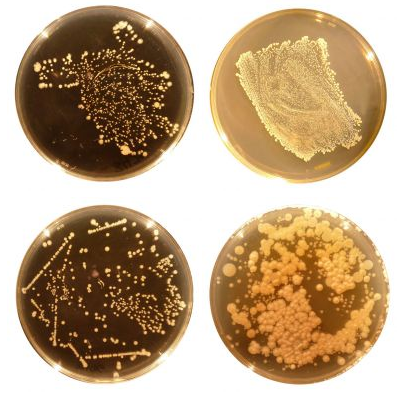Inside the Button

There’s a universe out there which we know about but can’t see, with literally thousands upon thousands of species doing things we don’t yet understand. We’re not talking about about spacemen from Mars or from galaxies far, far away though. These creatures are bacteria, and they are very much on Earth. For every cell our bodies have, there may be ten bacteria living within us, per one study from a few years ago. And finding some interesting collections of these bacteria is easy — as easy as swabbing your navel with a cotton swab.
That’s right: there’s a lot of stuff living in your belly button.
The images above come from a project called “Belly Button Biodiversity,” or BBB,” led by a group of “biologists and science communicators” from North Carolina State University and the North Carolina Museum of Natural Sciences. They realized that our belly buttons are a great place to find bacteria, for a bunch of reasons. Everyone has one, so you can get samples from virtually anyone. We don’t tend to wash them (and may not have to, beyond normal baths or showers), allowing all sorts of stuff to gather and grow there. And let’s face it, dust and lint and dirt and other stuff manage to find its way into our belly buttons pretty regularly. All together, our belly buttons can act as a journal of sorts, chronicling our travels and lives — but bacteria, not words, tell the story.
And, as the BBB team discovered, every navel tells its own tale. Pictured above are four samples from the BBB’s “bacteria galleries,” and it’s pretty clear that each one is different — very different, in some cases. While there are only eight different types (species) of bacteria which are common among most samples, the BBB project identified well over 2,300 others scattered throughout the landscape of belly button world. Because of this, the official paper written by the researchers concluded that the bacteria in our belly buttons are “highly diverse” and, as the Atlantic points out, “individual profiles were snowflake-ily, bacterially unique.” The Atlantic even went as far as to joke that police could take belly button bacterial examples instead of fingerprints. (Beyond being gross and intrusive, that wouldn’t work because the bacterial makeup of our belly buttons changes over time.) In short: everyone’s belly button bacteria is different.
We now have all this bacteria and a lot of data — but not a lot of answers to some of the most basic questions. Even accounting for our day-to-day activities, this diversity is not yet something we understand — it’s unknown why some people are breeding grounds for some types of bacteria, while otherwise similar people find entirely different sets of these microorganisms in their navels. (One person had bacteria which previously was only found in soil samples Japan, even though he had never been there.) Even then, it’s not clear why the bacteria are there or where they came from in the first place — nearly 1,500 of the discovered bacteria were newly identified species. And while some of the bacteria are probably good for us, most of the bacteria don’t do anything one way or another… we think.
Over time, science hopes to better understand these microorganisms carried around by our umbilical scars. But for now, the BBB is off to new frontiers. Emboldened by the discovery of new life forms, they’re now beginning to explore armpits.
Bonus Fact: Take some milk, add some bacteria, and you’re on your way to making cheese. It turns out that most any bacteria will do, so long as you don’t insist on making the cheese edible. Normally, inedible cheese wouldn’t be worth the trouble, but the intersection of science and art says otherwise. In November of 2013, the Dublin Science Gallery announced an installation called “Selfmade” — a collection of “microbial sketches” consisting of “portraits reflecting an individual’s microbial landscape in a unique cheese.” That’s right — they made cheese out of the bacteria found on the bodies of (in this case, 11) different people and called it art. But it is absolutely not to be called “dinner.” Gross.
From the Archives: The Chimera: The bonus fact is about belly buttons. The main story is amazing.
Related: The Belly Button Book: A board book for two- to four-year-olds, and a personal favorite. 4.7 stars on well over 100 reviews.
